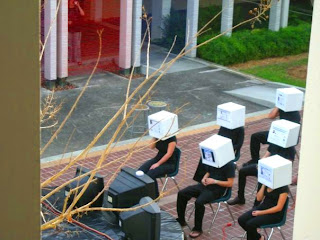Space as MovementBefore my research of the central patio if the FAH building, I stepped back and observed the FAH building as a whole and it very much influenced my interpretations of our patio. The building is for the most part broken up into three different sections. I refer to them as the art side, the administration section, and the music side, and there are two central patios; the one we are analyzing and another one in the music section of the building. I noticed that these two patios are visually very much the same in size and layout, but are occupied in very different ways. In fact, the other patio seems to be occupied by students significantly more than our patio is, and it is a place for students to collaborate on projects, eat lunch between classes, and socialize. I think this has to do with the uses we have given “our” patio (vs. that the music students have given theirs) and the different needs for space the art students have. The variation in occupancy between these two seemingly identical spaces interested me the most in my preliminary observations of the space, so I choose to analyze the central patio space of the FAH building using the Space as Movement approach.
I have always been fascinated with public spaces and how people move about them. The way people move through a space directly corresponds to the character of that space, and the use people assign it. The FAH patio is used by art students mostly as a space to display artwork (like the big murals that are sometimes up at either end) or as a space for instillations of artwork. It is a large space that doesn’t seem to get large amounts of student traffic, so it could be a desirable location for a larger more intrusive instillation of work. It is also sometimes used for art supply sales or ceramic sales. Circulation of the space is minimal. When students get out of class they usually follow the walk way around the patio rather than cutting through it. However, the pillars that surround the space make it feel intimate and somewhat closed while also giving full visibility of the space from every angle, even above. This could positively affect the work because it would allow something large, that perhaps filled the whole space, to be seen from every angle. Also, on a smaller scale, the pill in the center of the patio could serve as platform for a smaller piece, or even an interactive one. Because it would be placed on the platform, the piece would feel more featured (if that was the desired effect.) Also, an interactive piece would be accessible that way form all sides. Through the daytime the occupancy of the space doesn’t change too much. Occasionally there is a person or two sitting at the tables or on the benches, and the most traffic, which is generally just a few people, is between classes. When the sun goes down, I would assume there would be even less movement because the darkness discourages out door leisure, and most students and teachers leave USF to go home for the night.
I think an interesting way to utilize this space would be with something that alters the normal use of the space, and the normal movement and circulation of people around the space.











 This is the drawing I made in the exhibit.
This is the drawing I made in the exhibit.






